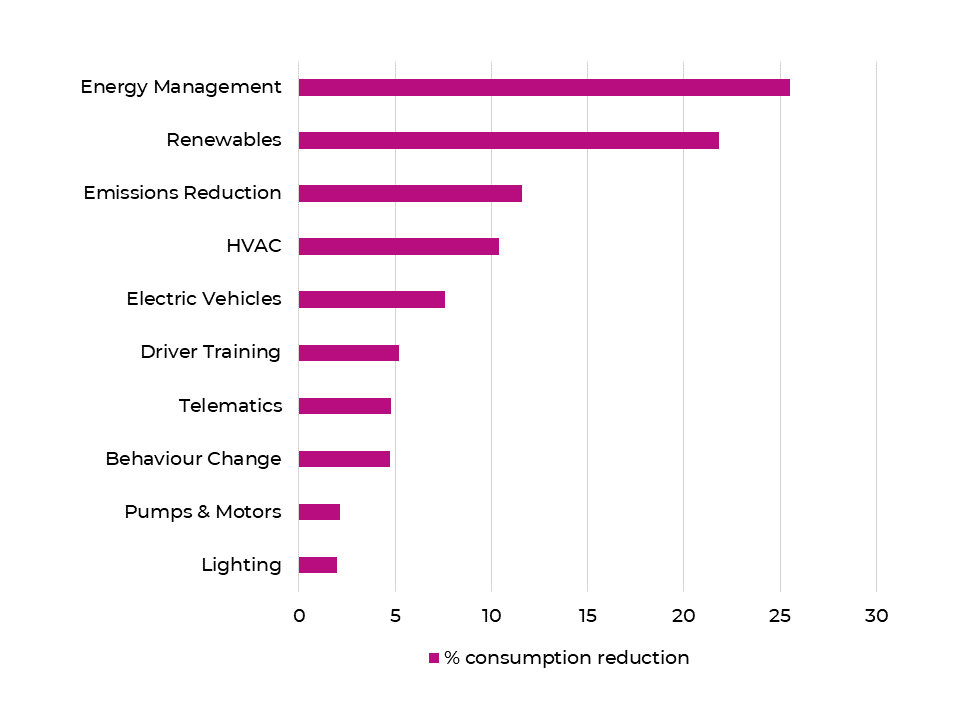
What’s next for ESOS Phase 3 participants?
ESOS compliance has entered a new era where pinpointing energy efficiency opportunities must lead to demonstrable action.
ESOS compliance has entered a new era where pinpointing energy efficiency opportunities must lead to demonstrable action.
Only months after the ESOS Phase 3 submission deadline, participants must publish an Action Plan by 5 December 2024 and report on their progress annually.
What has led us here?
As ESOS was first introduced in 2014, it could be easy to see this scheme as an established compliance exercise where each qualifying organisation has their settled internal routine of collating the required information and notifying the Environment Agency.
However, things have changed. Until recently, the ESOS scheme has required qualifying UK organisations, mostly large businesses, to assess their buildings, industrial processes and transport energy usage every four years to identify efficiency opportunities. Submitting a compliance notification has then marked a time of calm before the next audit.
Now ESOS Phase 3 participants are required to publish an Action Plan off the back of their findings and annually report on their progress to the Environment Agency.
While it is still not yet mandatory to implement your energy efficiency measures, the Environment Agency will publicly disclose whether your organisation has stated what you’re going to do and whether anything has been done in the subsequent years through your annual progress updates. Therefore, old ways of addressing ESOS compliance must be overhauled.
Updated Phase 3 reporting requirements
In previous compliance periods, ESOS participants were able to exclude up to 10% of their energy supplies and report on 90%. In Phase 3 this changed to a 5% exclusion, therefore reporting on at least 95% of your total energy consumption.
Whether you’re a new or seasoned ESOS participant, new requirements mean organisations need more time to collate the required information, engage with internal stakeholders and develop a structured approach to tracking and reporting your progress.
The ensuing Action Plan and subsequent annual progress reporting also create new demands of organisations. Energy efficiency recommendations in ESOS reports are often quite high level and based on industry-standard assumptions. These conceptual recommendations must now be turned into tangible and demonstrable action.
What’s next for Phase 3 participants?
Getting your Action Plan ready for submission
Your Action Plan, which must be approved by a board-level director, must set out:
- What you intend to do to reduce energy consumption and when.
- Whether it was recommended through your ESOS assessment.
- What energy savings you expect to achieve over the period covered by the Action Plan.
- How you estimated these savings.
Reporting on your progress
Comprehensive and current data forms the foundation of an ambitious and achievable Action Plan, as well as demonstrating your progress in annual reporting.
Energy efficiency and decarbonisation are company-wide efforts. Furthermore, as your Action Plan must be signed off by a board-level director, presenting accurate, comprehensive and current data against your actions and progress towards them in your ESOS compliance has never been more crucial.
What has Inspired learned from Phase 3?
- We were ready to support our clients in the new ESOS landscape. As Inspired wants to provide a comprehensive ESOS service, we were already including much of the additional reporting in our summary reports.
- Intensity Metrics were introduced. The late-stage introduction meant many organisations were not capturing their data in a way which could be used to report on their intensity metric. The Environment Agency’s preferred metric for buildings is kilowatt-hour per square metre (kWh/sqm) and many organisations did not know the square metres of their buildings. However, other metrics, such as turnover, could be used instead. At this late stage the metrics are likely to be less accurate but future phases will be more accurate and allow for more detailed insights.
- Transport metrics proved challenging. The Environment Agency’s preferred transport metrics are person mile travelled (for passenger transport) or tonne mile travelled (for freight transport). As this requirement was introduced late, passenger miles proved more challenging for many organisations. However, organisations have time to plan and embed processes to allow this information to be collected more accurately for Phase 4.
- Portal testing supported our robust service offering and overall user experience. Participating in the User Acceptance Testing of the Environment Agency’s MESOS portal allowed Inspired to refine our reporting templates, stay informed of system development and lobby our viewpoints in the best interest of our clients’ future compliance obligations. For example, we identified unexpected errors and raised them during portal testing. Consequently, scripts were updated to make error messages more informative – benefiting our clients and other users.
- Our clients were supported with portal registration. On 4 June 2024, the Environment Agency announced removal of the requirement to be registered with the MESOS portal by the following day due to technical difficulties organisations were encountering. Our clients were not in this position due to our diligent support process.
- 99.5% of Inspired’s clients had successfully registered their organisation on the MESOS portal for the original 5 June 2024 deadline. While some clients encountered technical difficulties, many of them were resolved quickly.
ESOS trends
The below chart shows the Total Energy Consumption for our client base.
80% of energy use accounted for industrial process, 12% for buildings and 8% for transport. Naturally, the mix will differ at company level. For example, a logistics company will differ from a manufacturer.
Total Energy Consumption by Category

Many savvy organisations are collecting energy through AMR technologies and accessing this data through energy management systems.
Transportation can be a more problematic area as less equipped collection processes tend to be in place for this data. As transport audits are increasingly coming into scope and annual reporting is introduced, organisations need to consider improving their data collection processes.
Top 10 ESOS identified saving opportunities by category

An ESOS Audit is designed to identify tailored and cost-effective measures that are reasonable and practicable to implement.
Therefore, it is unsurprising that energy management practices and short-term capital investment with less than three years’ payback were at the forefront of identified energy efficiency opportunities for our clients.
What types of opportunities and savings do the top 10 categories cover?
Energy Management
- Energy Management System.
- Meter upgrades.
- Monitoring & Targeting (M&T) – including Half Hourly (HH) AMR data and circuit level data.
- Building Management Systems.
- ISO 50001
Renewables & Fuel Switching
- Solar is the most recommended opportunity with payback typically less than five years, with some clients’ estimated payback expected in as little as three years.
Heat Recovery
Emissions reductions
- Mainly transport-related. Typical transport recommendations include electric vehicles, telematics, speed limiters, driver training and HGV Solar.
HVAC
- AC upgrades.
- Boiler replacements.
- AC control setting (mainly thermostat adjustment).
Behaviour Change
- Behaviour change strategy.
- Appointing a Green Team.
- Staff training.
- Staff engagement.
- League tables (visibility of site usage & costs).
- Poster campaigns.
- Open and close procedures.
Lighting
Mainly LED upgrades. Payback is typically between two and four years.
What quick wins can you consider?
Our ESOS summary reports have a section designated to quick wins with payback in less than 12 months. Some examples include:
- Environmental Policy: Simply having a policy in place will demonstrate your commitment to decarbonisation and wider environmental issues. It will also define key business improvements which can be used to measure progress and demonstrate performance. This could include ensuring the right processes are in place to meet mandatory and voluntary compliance schemes, reduce waste, and minimise your environmental impact.
- A behaviour change programme: A programme or a campaign can empower your significant energy users to cut down unnecessary energy and water use and adopt energy-efficient processes. For example, this could include energy awareness training, increased visibility of energy use and associated costs and alerts when agreed use thresholds are breached.
- Review Heating, Ventilation, and Air Conditioning (HVAC) and Building Management System (BMS) controls: Adjusting the temperature of your HVAC controls during summer and winter months can deliver excellent energy savings. For example, a 1°C adjustment can save 10% in energy consumption. Equally, BMS controls should be regularly reviewed to ensure optimisation. This could include enabling your building and/or plant equipment to respond to time, temperature levels or even occupancy.
How can Inspired help?
Producing a comprehensive ESOS submission is a complex, specialised process and getting it wrong may result in financial penalties and reputational damage.
Inspired has a strong track record of offering comprehensive ESOS support. We have completed 1,000 ESOS submissions and over 3,900 site audits for our clients. The Environment Agency has passed 100% of our audits and we are highly commended by auditors.
We also offer a wide range of efficiency and on-site generation solutions to support your ESOS compliance, from feasibility studies and project implementation to ongoing management.
How can we help you with your Action Plan?
Your ESOS submission will feature various energy efficiency opportunities and now you must choose what you wish to explore further or implement, on which sites and over what period. Our compliance experts can help you define a meaningful Action Plan.
Progress updates
Reporting on progress against your Action Plan includes updating your evidence pack with calculations of estimated energy savings achieved. We can review your Action Plan progress, update your evidence pack and advise you on the next steps. You will also have access to our interactive ESOS dashboard to view all your compliance data and evidence pack.
How can Inspired help?
Contact us today to find out how we can support your organisation with your compliance. Please call 01772 689250 or email us at [email protected]










